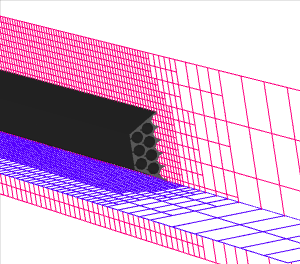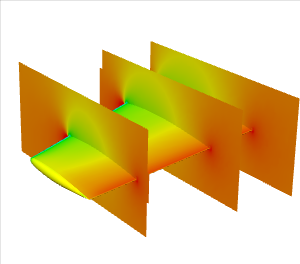Embedded Boundary Methods
The long-term goal of this project is to develop automatic
algorithms and software to simulate fluid flow in complex
geometries. Our approach is based on the use of Cartesian meshes
with embedded boundaries. Most of the domain is covered by
completely regular Cartesian cells, where fast and efficient
finite volume schemes have been developed. Most of the difficulty
both mathematically and in implementation comes from the cut
cells which intersect the boundary of the solid objects.
Grid generation is extremely fast, robust, and automatic. Our method
takes as input a watertight triangulation of the surface, and returns
the Cartesian mesh, where the cut cells are identified along with
their volume, face centroids, and the cut triangles inside of each cut cell.
The tools we've developed for this can generate a mesh with millions of cells
in minutes on a desktop workstation. Some examples are shown here; see the
Cart3D web site
for more.

|
 |

|
 |
The ongoing challenge is to find stable and accurate difference schemes
where
the Cartesian cells intersect the body. For steady state problems,
second order finite volume schemes have been developed. Since for
time-dependent problems, explicit
schemes usually have a CFL condition that depends on the cell volume,
new approaches are needed to develop a scheme that maintains stability
in the presence of arbitrarily small cut cell sizes. We are
developing h-box
methods -- difference schemes with an enlarged stencil in rotated
coordinates -- to tackle this problem.
For technical references see:
- Robust
and Efficient Cartesian Mesh Generation for Component-based
Geometry,
Aftosmis, Berger and Melton, AIAA 97-0196.
- A
Parallel Multilevel Method for Adaptively Refined Cartesian Grids with
Embedded Boundaries, Aftosmis, Berger and Adomavicius, AIAA
2000-0808
- A
High-Resolution Rotated Grid Method for Conservation Laws with Embedded
Boundaries, Helzel, Berger and Leveque, SISC 26(3),
2005.
Other Links:
- EBChombo (another
approach to embedded boundary and the small cell problem from
LBL ANAG group)
- see publications by W. Shyy,
professor of aero. engg. at Michigan, for alternative difference
schemes at the embedded boundary
- Comprehensive review of Meshing
Software




